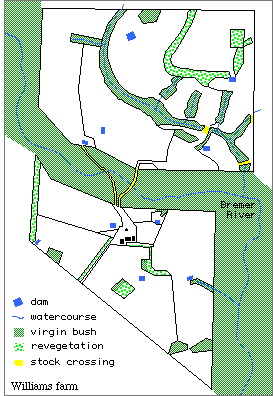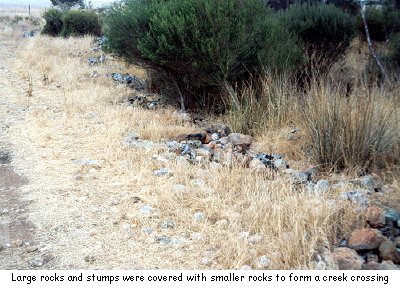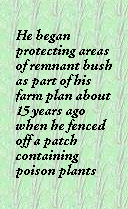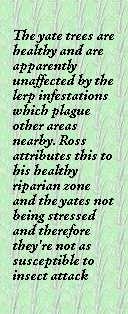
Ross and Rhonda Williams, Meechi Road, Gairdner

|
Bremer River tributary protection
Ross and Rhonda Williams, Meechi Road, Gairdner |
 |
 The Site
The Site
Ross Williams bought his conditional purchase block (Location 1874) in 1968 and started clearing and developing the land for sheep and crops in 1975. The Bremer River runs through the property but was not surveyed as part of the farm. A vegetated corridor was fenced to form a protected river reserve in 1970. Ross also has tributaries to the river on the property and he decided not to clear them because he was aware of the erosion that would have occurred. He wanted to keep the vegetation along the creek as he had noticed large amounts of runoff from the cleared property to the north. The creek had flooded many times with the water reaching heights of five metres. Devil's Creek Road, to the north, had been washed away four times. During these floods he saw the unfenced creek banks further upstream erode back between two and three metres. The Problem He began protecting areas of remnant bush as part of his farm plan about 15 years ago when he fenced off a patch containing poison plants (Gastrolobium species). After seeing what had happened on a neighbour's property, Ross fenced the western end of a tributary of the Bremer River in 1985. "There was land cleared up there and within three years of it being cleared the creekline was showing signs of salt. They had never done anything about fencing it out and I thought well there's no point leaving all this nice bush to go like that. Obviously the salt was very close to the surface then and the natural bush was only just holding it in balance". Ross was also concerned about his sheep having access to the creekline: "I guess the sheep probably would have eaten some of the small stuff out but there were only sheep in here for a few years after it was cleared, so they didn't get a chance to eat it out really. The other end (eastern) is a lot thinner and there's a lot more grass in it". He had also noticed that the sheep really liked to eat the acacias.
Ross fenced the eastern end of the creek in 1996 and the difference in the density of vegetation between the two areas that were fenced at different times can be seen in the photos. There is less understorey in the recently fenced area, although the overstorey is healthy. Since fencing Ross has noticed some natural revegetation in both sections of the creek. The water is cleaner even though the same amount of water is running off the land and Ross puts this down to having a grassed waterway adjacent to the creek. About 12 years ago Ross established a stock crossing for his sheep and also for large machinery access. There was an old crossing further upstream but this had proved to be unstable. "I found that one was eroding, water was coming down there and I thought I'd put it in on the angle but the water was hitting the wheel tracks and just cutting it out where I was driving all the time. When I had a rethink I decided that it was shorter to go straight across the creek with the rock than try and do a longer stretch. The erosion was the problem with the one up there, it didn't have any rocks".
Rocks were picked up with a front-end loader from one of the neighbouring properties. Big rocks and stumps were put in first and then covered with smaller rocks and no soil or pipes were used. Since then the crossing has experienced some flooding but it has remained stable. "I'm happy with it; it's ideal for what we do. Our widest machine is 20 feet and it's also wide enough for sheep".
Ross explained that the fencing of the creeks and protection of the riparian vegetation has been good for stock shelter both in hot and cold weather. He has also been practising no-till and hasn't seen any erosion from the paddocks into the creek in recent times. Ross has also noticed a decrease in wind erosion on the farm. He has been able to increase his stocking rates because of the increase in feed since using no-till practises and also by having shelter belts for sheep protection.
The yate trees are healthy and are apparently unaffected by the lerp infestations which plague other areas nearby. Ross attributes this to his healthy riparian zone and the yates not being stressed and therefore they're not as susceptible to insect attack.

Bremer River tributary catchment statistics
Map Reference: 1:50 000 2729 III and IV |
||||||||||||
 |
|||||||||||||
 |
|||||||||||||
 |
|||||||||||||
 |